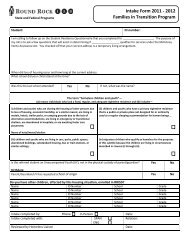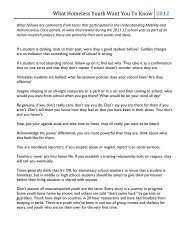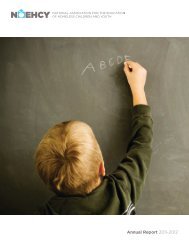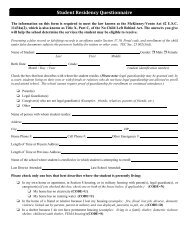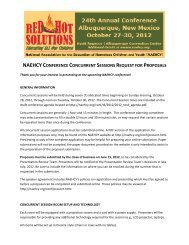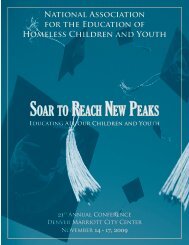The McKinney-Vento Act and Children and Youth ... - State of Michigan
The McKinney-Vento Act and Children and Youth ... - State of Michigan
The McKinney-Vento Act and Children and Youth ... - State of Michigan
Create successful ePaper yourself
Turn your PDF publications into a flip-book with our unique Google optimized e-Paper software.
<strong>and</strong> underst<strong>and</strong>ing <strong>of</strong> the <strong>McKinney</strong>-<strong>Vento</strong> <strong>Act</strong> within child welfare agencies.<br />
Establishing education specialists <strong>and</strong> adequately training caseworkers on the<br />
<strong>McKinney</strong>-<strong>Vento</strong> <strong>Act</strong> would help relieve some <strong>of</strong> this burden.<br />
Many homeless liaisons have increased their capacity to ensure immediate<br />
enrollment for students experiencing homelessness by designating a homeless<br />
contact in every school building. <strong>The</strong> contact may be a school counselor,<br />
nurse, secretary, or other staff person. <strong>The</strong> homeless liaison trains the<br />
contact on the <strong>McKinney</strong>-<strong>Vento</strong> <strong>Act</strong>, possible indicators <strong>of</strong> homelessness,<br />
<strong>and</strong> the services <strong>and</strong> protections the school district can provide. <strong>The</strong> contact<br />
then serves as the liaison’s “eyes <strong>and</strong> ears” in that school building, helping<br />
to identify <strong>McKinney</strong>-<strong>Vento</strong> students <strong>and</strong> ensure that they are served<br />
appropriately. An additional strategy to support the work <strong>of</strong> homeless liaisons<br />
is to provide them with administrative assistants or other support staff who<br />
can coordinate transportation, help disburse school supplies, <strong>and</strong> work directly<br />
with schools.<br />
Both child welfare <strong>and</strong> education agency staff must work in t<strong>and</strong>em with the<br />
adult decision-makers in youth’s lives. Someone must decide what school the<br />
youth will attend, enroll the youth, <strong>and</strong> make decisions about the student’s<br />
educational program. For youth in out-<strong>of</strong>-home care, it is <strong>of</strong>ten unclear which<br />
adult is empowered to fill that role. <strong>The</strong> following section addresses this<br />
complex issue.<br />
5. Clarify education-related roles <strong>and</strong> responsibilities<br />
“ <strong>The</strong> organizational structure is difficult for us, because sometimes we don’t know who’s<br />
responsible for what.”<br />
— Elizabeth Hinz 48<br />
Biological parents, foster parents, kinship care providers, attorneys, judges,<br />
caseworkers, supervisors, group home staff, education advocates, teachers,<br />
school counselors, homeless liaisons, <strong>and</strong> many other adults <strong>and</strong> agencies may<br />
touch the life <strong>of</strong> a youth who is awaiting foster care placement. Each plays<br />
a role in the youth’s education. If their respective roles <strong>and</strong> responsibilities<br />
are not clarified, disputes may arise regarding educational decisions. Worse,<br />
an important decision or action may be delayed while the various parties<br />
try to decide whose job it is. To avoid such consequences, education-related<br />
responsibilities must be clearly addressed <strong>and</strong> assigned, including the following:<br />
40 <strong>The</strong> <strong>McKinney</strong>-<strong>Vento</strong> <strong>Act</strong> <strong>and</strong> <strong>Children</strong> <strong>and</strong> <strong>Youth</strong> Awaiting Foster Care Placement




